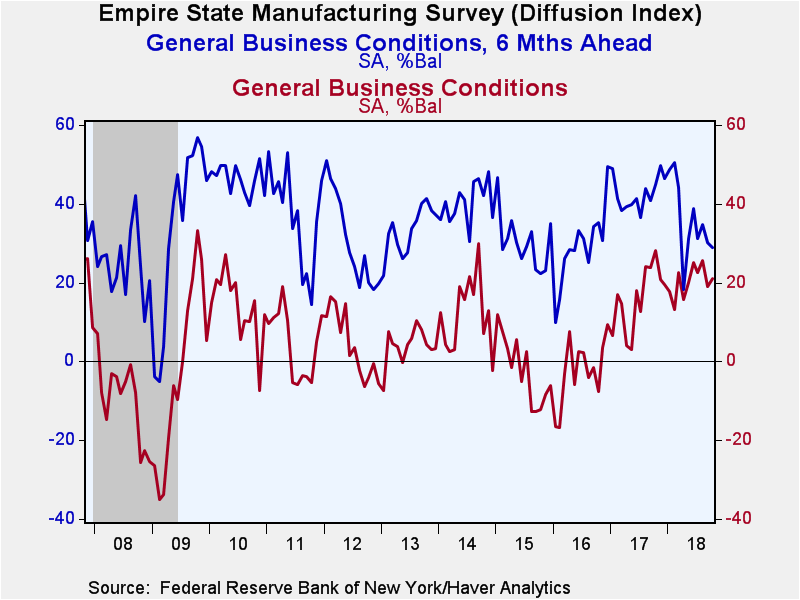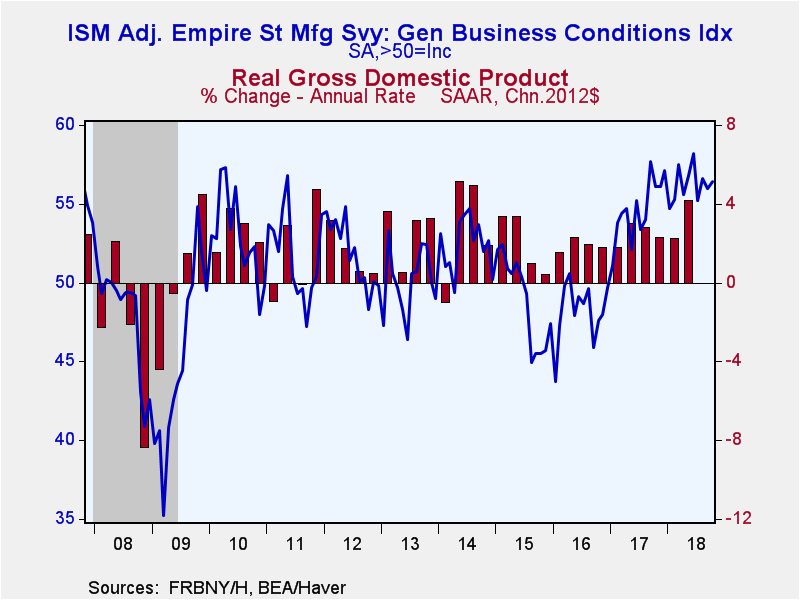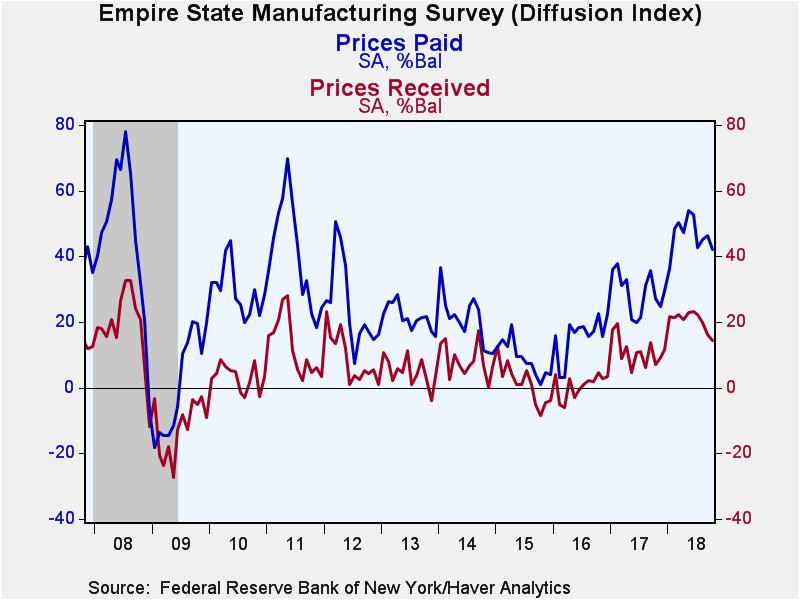 Global| Oct 15 2018
Global| Oct 15 2018Empire State Manufacturing Index Increases; Prices Decline
Summary
The Empire State Manufacturing Index of General Business Conditions rose to 21.1 in October, reversing some of September's decline to 19.0. This survey has been range-bound for roughly the last year. The Action Economics Forecast [...]
The Empire State Manufacturing Index of General Business Conditions rose to 21.1 in October, reversing some of September's decline to 19.0. This survey has been range-bound for roughly the last year. The Action Economics Forecast Survey expected a reading of 19.1. The Empire State data, reported by the Federal Reserve Bank of New York, reflect business conditions in New York, northern New Jersey and southern Connecticut.
Haver Analytics calculates a seasonally adjusted index that is comparable to the ISM series. The calculated figure increased to 56.4 from 56.0. During the last ten years, the index has had a 69% correlation with the quarter-to-quarter change in real GDP.
While the new orders and shipments readings increased -- with both measures at roughly one-year highs -- all of the other production-related indices declined. Most notably, unfilled orders dropped from 4.9 to -8.4, the lowest reading this year. The number of employees index decreased to 9.0 from 13.3. During the last ten years, there has been a 77% correlation between the employment index and the month-to-month change in factory sector payrolls. Just 15.1% of respondents reported increased employment, a 15-month low, while 6.1% showed a decrease. The employee workweek reading fell to 0.2 from 11.5, also a 15-month low.
The prices paid index declined to 42.0 from 46.3, its lowest level since January. Forty-five percent of respondents indicated increased prices, while just three percent reported a decrease. Prices received fell to the lowest level since December.
The series measuring expectations for business conditions in six months declined to 29.0 though is still well above April's 18.3 reading. Expected prices paid decreased from September's eight-year high.
The Empire State figures are diffusion indexes, which are calculated by subtracting the percent of respondents reporting declines from those reporting gains. The data are available in Haver's SURVEYS database. The ISM-adjusted headline index dates back to 2001. The Action Economics Forecasts can be found in Haver's AS1REPNA database.
| Empire State Manufacturing Survey | Oct | Sep | Aug | Oct'17 | 2017 | 2016 | 2015 |
|---|---|---|---|---|---|---|---|
| General Business Conditions (Diffusion Index, %, SA) | 21.1 | 19.0 | 25.6 | 28.1 | 16.1 | -2.6 | -2.3 |
| General Business Conditions Index (ISM Adjusted, >50=Increasing Activity, SA) | 56.4 | 56.0 | 56.6 | 56.1 | 54.6 | 48.2 | 48.8 |
| New Orders | 22.5 | 16.5 | 17.1 | 21.0 | 14.6 | -0.8 | -5.6 |
| Shipments | 26.3 | 14.3 | 25.7 | 26.4 | 15.9 | 1.9 | 4.0 |
| Unfilled Orders | -8.4 | 4.9 | 11.1 | 2.3 | 1.9 | -8.8 | -10.5 |
| Delivery Time | 5.0 | 6.5 | 10.4 | 3.1 | 6.1 | -4.8 | -5.3 |
| Inventories | 0.8 | 8.9 | 0.0 | -7.8 | 1.5 | -9.6 | -7.1 |
| Number of Employees | 9.0 | 13.3 | 13.1 | 18.1 | 8.3 | -5.1 | 2.3 |
| Average Employee Workweek | 0.2 | 11.5 | 8.9 | 3.2 | 4.9 | -5.2 | -4.8 |
| Prices Paid | 42.0 | 46.3 | 45.2 | 27.3 | 29.0 | 15.7 | 8.8 |
| Prices Received | 14.3 | 16.3 | 20.0 | 7.0 | 11.0 | 0.7 | 1.2 |
| Expectations 6 Months Ahead | 29.0 | 30.3 | 34.8 | 44.9 | 42.6 | 29.0 | 30.3 |
Gerald D. Cohen
AuthorMore in Author Profile »Gerald Cohen provides strategic vision and leadership of the translational economic research and policy initiatives at the Kenan Institute of Private Enterprise.
He has worked in both the public and private sectors focusing on the intersection between financial markets and economic fundamentals. He was a Senior Economist at Haver Analytics from January 2019 to February 2021. During the Obama Administration Gerald was Deputy Assistant Secretary for Macroeconomic Analysis at the U.S. Department of Treasury where he helped formulate and evaluate the impact of policy proposals on the U.S. economy. Prior to Treasury, he co-managed a global macro fund at Ziff Brothers Investments.
Gerald holds a bachelor’s of science from the Massachusetts Institute of Technology and a Ph.D. in Economics from Harvard University and is a contributing author to 30-Second Money as well as a co-author of Political Cycles and the Macroeconomy.









